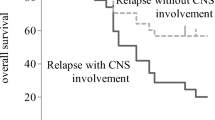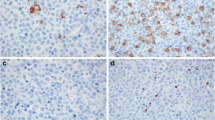Abstract
Several biomarkers have been identified as prognostic factors in primary central nervous system lymphoma (PCNSL). However, the correlation between the histogenetic origin of PCNSL and the response to therapy is still unclear. To elucidate the utility of immunophenotypic markers in predicting clinical outcomes, we investigated 27 immunocompetent patients with PCNSL treated with high-dose methotrexate therapy. Of the 27 patients, 25 received whole-brain radiotherapy after high-dose methotrexate. Immunostaining for CD5, CD10, BCL-6, and MUM-1 was used to determine the immunophenotypic profile of diffuse large B-cell lymphoma of PCNSL. We then evaluated whether immunophenotypic markers were associated with the response to therapy or patients’ survival. The response to induction high-dose methotrexate therapy was determined by magnetic resonance imaging after three courses of i.v. high-dose methotrexate. We categorized B-cell lymphomas into three known subtypes: germinal center B-cell (GCB), activated-GCB, and post-GCB subtypes according to immunohistochemical profile. All the BCL-6-positive samples were co-positive for MUM-1 and therefore classified into activated-GCB subtype. BCL-6 expression in this study was associated with poor progression-free survival (P = 0.038). No immunophenotypic markers or subtypes had a significant effect on the response to high-dose methotrexate therapy. However, the response itself was a significant predictor for both progression-free survival (P < 0.001) and overall survival (P = 0.003). Further investigation is needed to assess BCL-6 as a potential prognostic factor in PCNSL.




Similar content being viewed by others
References
Coté TR, Manns A, Hardy CR et al (1996) Epidemiology of brain lymphoma among people with or without acquired immunodeficiency syndrome. AIDS/Cancer Study Group. J Natl Cancer Inst 88:675–679
Olson JE, Janney CA, Rao RD et al (2002) The continuing increase in the incidence of primary central nervous system non-Hodgkin lymphoma: a surveillance, epidemiology, and end results analysis. Cancer 95:1504–1510
Abrey LE, Yahalom J, DeAngelis LM (2000) Treatment for primary CNS lymphoma: the next step. J Clin Oncol 18:3144–3150
DeAngelis LM, Seiferheld W, Schold SC et al (2002) Combination chemotherapy and radiotherapy for primary central nervous system lymphoma: Radiation Therapy Oncology Group Study 93-10. J Clin Oncol 20:4643–4648
Paulus W (1999) Classification, pathogenesis and molecular pathology of primary CNS lymphomas. J Neurooncol 43:203–208
Alizadeh AA, Eisen MB, Davis RE et al (2000) Distinct types of diffuse large B-cell lymphoma identified by gene expression profiling. Nature 403:503–511
Rosenwald A, Wright G, Chan WC et al (2002) The use of molecular profiling to predict survival after chemotherapy for diffuse large-B-cell lymphoma. N Engl J Med 346:1937–1947
Dent AL, Shaffer AL, Yu X et al (1997) Control of inflammation, cytokine expression, and germinal center formation by BCL-6. Science 276:589–592. doi:10.1126/science.276.5312.589
Dogan A, Bagdi E, Munson P et al (2000) CD10 and BCL-6 expression in paraffin sections of normal lymphoid tissue and B-cell lymphomas. Am J Surg Pathol 24:846–852
Falini B, Fizzotti M, Pucciarini A et al (2000) A monoclonal antibody (MUM1p) detects expression of the MUM1/IRF4 protein in a subset of germinal center B cells, plasma cells, and activated T cells. Blood 95:2084–2092
Natkunam Y, Warnke RA, Montgomery K (2001) Analysis of MUM1/IRF4 protein expression using tissue microarrays and immunohistochemistry. Mod Pathol 14:686–694
Hans CP, Weisenburger DD, Greiner TC et al (2004) Confirmation of the molecular classification of diffuse large B-cell lymphoma by immunohistochemistry using a tissue microarray. Blood 103:275–282. doi:10.1182/blood-2003-05-1545
Chang CC, McClintock S, Cleveland RP et al (2004) Immunohistochemical expression patterns of germinal center and activation B-cell markers correlate with prognosis in diffuse large B-cell lymphoma. Am J Surg Pathol 28:464–470
Camilleri-Broët S, Crinière E, Broët P et al (2006) A uniform activated B-cell-like immunophenotype might explain the poor prognosis of primary central nervous system lymphomas: analysis of 83 cases. Blood 107:190–196
Lin CH, Kuo KT, Chuang SS et al (2006) Comparison of the expression and prognostic significance of differentiation markers between diffuse large B-cell lymphoma of central nervous system origin and peripheral nodal origin. Clin Cancer Res 12:1152–1156
Levy O, Deangelis LM, Filippa DA et al (2008) Bcl-6 predicts improved prognosis in primary central nervous system lymphoma. Cancer 112:151–156
Matolcsy A, Chadburn A, Knowles DM (1995) De novo CD5-positive and Richter’s syndrome–associated diffuse large B cell lymphomas are genotypically distinct. Am J Pathol 147:207–216
Yamaguchi M, Seto M, Okamoto M et al (2002) De novo CD5+ diffuse large B-cell lymphoma: a clinicopathologic study of 109 patients. Blood 99:815–821
Maeshima AM, Taniguchi H, Nomoto J et al (2009) Secondary CD5+ diffuse large B-cell lymphoma not associated with transformation of chronic lymphocytic leukemia/small lymphocytic lymphoma (Richter syndrome). Am J Clin Pathol 131:339–346
Braaten KM, Betensky RA, de Leval L et al (2003) BCL-6 expression predicts improved survival in patients with primary central nervous system lymphoma. Clin Cancer Res 9:1063–1069
Sugita Y, Tokunaga O, Nakashima A et al (2004) SHP-1 expression in primary central nervous system B-cell lymphomas in immunocompetent patients reflects maturation stage of normal B cell counterparts. Pathol Int 54:659–666
McAllister LD, Doolittle ND, Guastadisegni PE et al (2000) Cognitive outcomes and long-term follow-up results after enhanced chemotherapy delivery for primary central nervous system lymphoma. Neurosurgery 46:51–60
Author information
Authors and Affiliations
Corresponding author
Rights and permissions
About this article
Cite this article
Momota, H., Narita, Y., Maeshima, A.M. et al. Prognostic value of immunohistochemical profile and response to high-dose methotrexate therapy in primary CNS lymphoma. J Neurooncol 98, 341–348 (2010). https://doi.org/10.1007/s11060-009-0078-z
Received:
Accepted:
Published:
Issue Date:
DOI: https://doi.org/10.1007/s11060-009-0078-z




